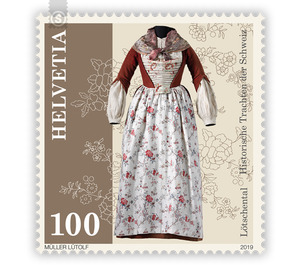Traditional costumes of Switzerland - Lötschental - Switzerland 2019 - 100 Rappen
| Country | Switzerland |
| Issue Date | 2019 |
| Face Value | 100.00 |
| Color | brown |
| Printing Type | offset |
| Stamp Type | Commemorative |
| Item Type | Stamp |
| SID | 980023 |
| Dimensions | 35.00 x 37.00 |
| In 9 Wishlists | |
Swiss costumes have a long tradition and are characterized by an extraordinary diversity. They are a valuable cultural asset of our country. Four stamps as a set in the special block impressively show this with historical examples. An exceptionally rich collection of historical costumes can be found in the Swiss National Museum. It is based on donations by the costume researcher Julie Heierli. From this collection, the philately-experienced Bernese studio Müller Lütolf has staged four copies. Left to right: Lötschental: a traditional costume, as it was worn in Valais Lötschental until well into the 19th century. Characteristic are the only reaching to the elbow red sleeves; under it was worn a shirt. The costume typically includes a head wreath. The apron consists of a printed cotton fabric. Friborg: a procession costume from the 19th century. In addition to the bulging sleeves, the big amulet, the "Ginge", is typical. The costumes are still used today in Düdingen, Tafers and Heitenried within the tradition of the "Kränzlitöchter"; It is worn by unmarried women together with ornate headdresses, the "Schapel". Valle Verzasca: a Sunday dress, as it was worn in the Maggiatal at the beginning of the 19th century. Like all historical costumes, it was based on the then current fashion. Accordingly, the high, below the breast fitting Empire waistline. Engiadina: This costume dates from the late 18th century. Since she too is based on the fashion of the time, she is referred to as Bünder "Rokokotracht". The "capadüsli" belongs to the clothing produced to this day as a headgear. The costume world of the region is documented and maintained by the Bünde traditional costume association.


